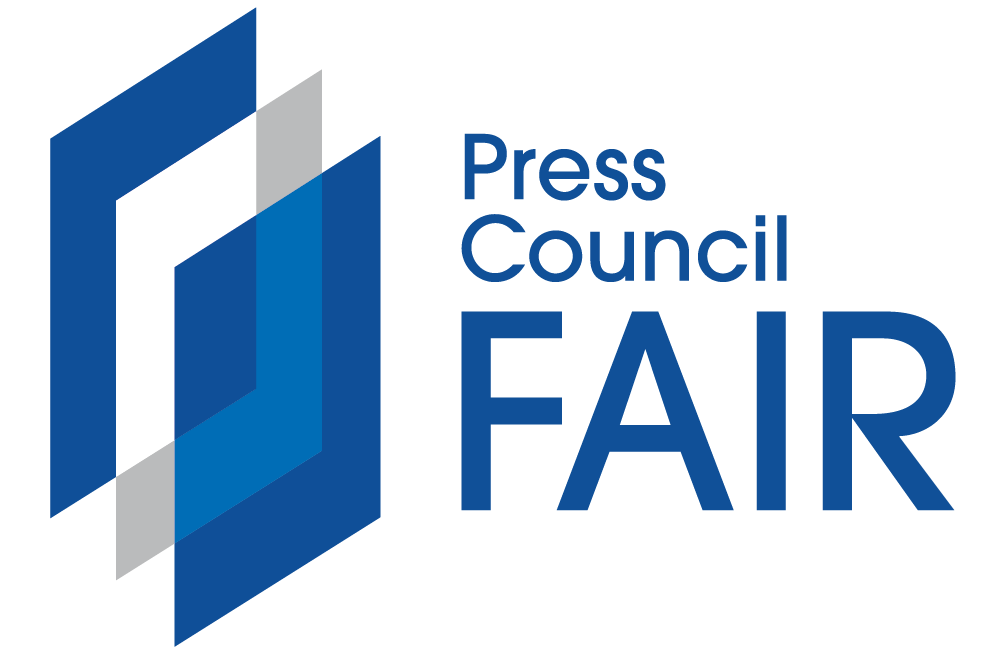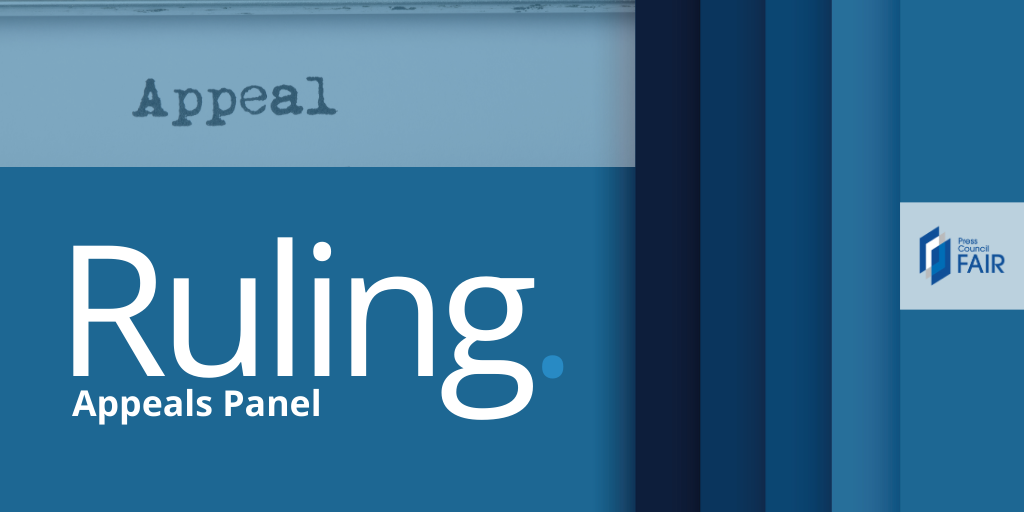Zephany Nurse vs. Daily Voice
SUMMARY
The headlines to the stories in dispute read, We got justice but lost Zephany (published on 14 March 2016); and, I’m here for you Zephany (March 165).
This ruling by Press Ombud Johan Retief was based on the Press Code that was in effect before 30 September 2022.
Zephany Nurse (18) was abducted as a baby from the Groote Schuur Hospital in April 1997 and was subsequently “discovered” by her biological parents in February 2015 – after which she became the subject of intense media coverage. The woman Nurse knew as her mother was convicted of kidnapping and awaiting sentencing at the time the disputed reports were published.
Nurse complained that Daily Voice published pictures of her:
- despite a court order prohibiting it from doing so;
- without exercising the necessary care and consideration, which led to the invasion of her privacy;
- without putting enough emphasis on the fact that she was a child (under 18) when the pictures were taken; and
- after having paid money to obtain these pictures.
Retief said the newspaper indeed acted in defiance of Justice Bertelsmann’s court order which inter alia stated: “The publication of any information which reveals or may reveal [her] identity is prohibited.” He said that Nurse’s face was pixelated – but the stories were about her, and nobody in her or his right mind would have interpreted the pictures other than to believe that they in fact did portray the girl. He said he firmly believed that Nurse’s right to privacy overrode that of the public interest in this matter and that it had unnecessarily added to her trauma.
Daily Voice was directed to apologise for the above. The complaint about payment for the picture was dismissed.
THE RULING ITSELF
This ruling is based on the written submissions of Prof Ann Skelton of the Centre for Child Law, for Ms Zephany Nurse, and those of Taariq Halim, editor of the Daily Voice newspaper.
Complaint
Nurse is complaining about two articles in the Daily Voice, headlined:
· We got justice but lost Zephany (14 March 2016, front page, continued on page 4); and
· I’m here for you Zephany (16 March 2016).
She complains that Daily Voice published pictures of her:
· despite a court order prohibiting it from doing so;
· without exercising the necessary care and consideration, which led to the invasion of her privacy;
· without putting enough emphasis on the fact that she was a child (under 18) when the pictures were taken; and
· after paying some money to obtain these pictures.
The text
Nurse (18) was abducted as a baby from the Groote Schuur Hospital in April 1997, and was subsequently “discovered” by her biological parents in February 2015 – after which she became the subject of intense media coverage.
The woman Nurse knew as her mother was convicted of kidnapping and awaiting sentencing at the time the disputed reports were published. This was also widely covered in both national and international media.
The stories were basically follow-ups on this saga.
Analysis
As background, Skelton says that Nurse has suffered significant trauma as a result of the events mentioned above – aggravated by “intrusive media reporting on her story”.
She explains, “[Nurse] desires to protect her privacy to allow her to come to terms with these events and to salvage some possibility of a normal life. As a result we have taken active steps to protect [her] anonymity and privacy. These steps include obtaining a court order prohibiting the publication of any information that reveals or may reveal [Nurse’s] identity.”
Justice Eberhard Bertelsmann issued such a court order on 21 April 2015.
Skelton submits that the articles displayed recent photographs of Nurse and her biological family, including full-length pictures with her face partially blocked out. “These photographs were taken at private reunions between [Nurse] and her biological family. These were highly emotional events for her. They were intensely personal and private events, as were the pictures concerned. Both photographs were taken when [she] was a child, that is under 18 years old.”
Skelton says Nurse trusted that these photographs would remain within the family, and their disclosure has caused her severe distress. She adds that the pictures were published without Nurse’s knowledge and consent.
Skelton says the stories were in breach of the following sections of the Code of Ethics:
3.1. The media shall exercise care and consideration in matters involving the private lives and concerns of individuals. The right to privacy may be overridden by the public interest; and
3.2. In the protection of privacy, dignity and reputation special weight must be afforded to South African cultural customs concerning the privacy and dignity of people who are bereaved and their respect for those who have passed away, as well as concerning children, the aged and the physically and mentally disabled. (Skelton’s emphases.)
Skelton argues that the articles breached these clauses, as the photographs depicted Nurse’s “private life and concerns”. She adds that there was no public interest which justified overriding her privacy, and argues that the newspaper did not afford special weight to her privacy interests – despite the fact that the photographs were taken when she was still a child.
Nurse also “reasonably suspects” that the newspaper has paid Mr Morné Nurse (Nurse’s
“adopted” father) for the use of the photographs. This belief is partly based on a recorded statement by him that he would not grant any interviews without “inconvenience compensation”. Nurse also has personal knowledge of the pressure exerted on family members by the media in exchange for personal information about her. Therefore, Nurse “has real and substantial reasons to believe that money was paid for the photographs”.
If this is true, she complains that the newspaper was in breach of Section 12 of the Code that reads, “The media shall avoid shady journalism in which informants are paid to induce them to give the information, particularly when they are criminals – except where the material concerned ought to be published in the public interest and the payment is necessary for this to be done.”
Halim denies that the newspaper, or its media house (Independent Media) made any payments to Mr Morné Nurse in exchange for information published in the articles in question.
He says the newspaper sourced Nurse’s photograph from Facebook. “The Daily Voice took care to pixelate the picture before publishing, in compliance with the court’s instruction to protect [Nurse’s] identity.”
My considerations
The first question is whether Daily Voice acted in defiance of Justice Bertelsmann’s court order, issued on 21 April 2015. The relevant part states:
“Irrespective of whether or not the second applicant (Nurse) has reached the age of 18 years, pending the final determination of Part B of this application:
“2.1 The publication of any information which reveals or may reveal [her] identity is prohibited;
“2.2 The first to seventh respondents (which includes Independent Media, and therefore also Daily Voice) are interdicted from publishing any information which reveals or may reveal her identity.”
True, the newspaper did pixelate Nurse’s face. However, I simply cannot take the editor’s argument seriously that the blurring of her face was done in compliance with the court’s instruction to protect her identity – the stories were about the girl, and nobody in her or his right mind could have interpreted the pictures otherwise than by believing that they in fact did portray Ms Nurse.
This, apart from the consideration that people close to Nurse would most probably have recognized her despite the pixelation.
It follows that I believe the coverage resulting in Nurse’s complaint indeed did not comply with Bertelsmann’s order, which stated clearly that information which reveals “or may reveal” her identity was prohibited.
The second issue is whether this defiance of the court order was justified. Law and ethics are not always congruent with each other, which is why Section 1.4 of the Code of Ethics and Conduct provides for the following: “News should be obtained legally … unless public interest dictates otherwise.”
The principle is set: The media may act illegally, if the public interest requires such actions.
The question, therefore, now becomes whether public interest was in this case so overriding that Daily Voice was justified in defying a court order.
I submit that the publishing of Nurse’s picture was more in the mould of “interesting to the public”, than in “the public interest”.
Another angle is the reason for Nurse finding it necessary to obtain such a court order. It was, of course, to protect her privacy. Bertelsmann clearly agreed with her – and so do I.
Therefore, even if there was a degree of public interest, I (firmly) believe that Nurse’s right to privacy overrides that of the public interest in this matter. It follows that I also believe that the publication of the pictures has unnecessarily added to Nurse’s trauma.
I therefore agree with Skelton’s arguments about the breaching of Sections 3.1 of the Code (save for her reference to the fact that the pictures were taken when Nurse was still a child, as the pictures were published after her 18th birthday – however, I hasten to add that this remark does not soften my arguments as outlined above).
The fact that the pictures were taken at a private (and highly emotional) meeting should also be considered. Daily Voice has entered the sanctity of that place and that moment – without enough justification for doing so.
I am in no position to find that Daily Voice has or has not paid for the use of the pictures, as I do not have any basis for making a definite decision in this regard. As it stands, I opt to accept the editor’s word on this matter.
Skelton asked for details of the relevant Facebook page. Quite correctly, the Public Advocate informed her that she could not request details about this issue from the editor, as it did not form part of the complaint. She advised Skelton to contact him directly.
Finding
Daily Voice is in breach of Section 3.1 of the Code of Ethics and Conduct which states, “The media shall exercise care and consideration in matters involving the private lives and concerns of individuals…”
The complaint about paying for the use of the pictures is dismissed.
Seriousness of breaches
Under the headline Hierarchy of sanctions, Section 8 of this office’s Complaints Procedures distinguishes between minor breaches (Tier 1), serious breaches (Tier 2) and serious misconduct (Tier 3).
I applied my mind as to whether the breach of the Code, as described above, constituted a Tier 2 or Tier 3 offence. After having given this matter much thought, I have eventually decided that the breach of the Code of Ethics and Conduct as indicated above constitutes a Tier 3 offence.
Sanction
Daily Voice is directed to apologise to Nurse for unnecessarily adding to her stress and trauma by invading her privacy with the publication of pictures of her – which, in any case, was in defiance of a court order prohibiting the newspaper from publishing anything that might reveal her identity.
This apology must be announced on page 1, with a reference to the full apology on page 4.
The text, which should be approved by me, should:
- start with the sanction; and
- end with the sentence, “Visit www.presscouncil.org.za for the full finding”.
The headline should reflect the content of the text. A heading such as Matter of Fact, or something similar, is not acceptable.
If the offending article appeared on the newspaper’s website, the apology should appear there as well.
Appeal
Our Complaints Procedures lay down that within seven working days of receipt of this decision, either party may apply for leave to appeal to the Chairperson of the SA Press Appeals Panel, Judge Bernard Ngoepe, fully setting out the grounds of appeal. He can be contacted at [email protected].
Johan Retief
Press Ombud


